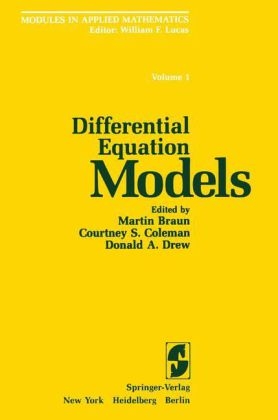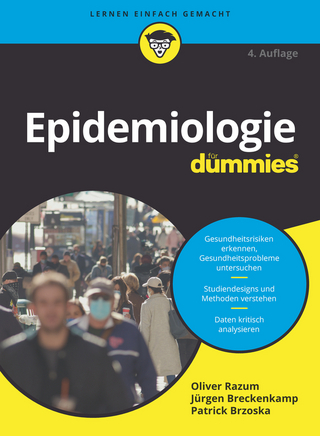
Modules in Applied Mathematics
Springer-Verlag New York Inc.
978-0-387-90695-9 (ISBN)
- Titel ist leider vergriffen;
keine Neuauflage - Artikel merken
I. Differential Equations, Models, and What To Do with Them.- 1. Setting Up First-Order Differential Equations from Word Problems.- 1. Introduction.- 2. Guidelines.- 3. Examples.- Exercises.- Solutions.- Notes for the Instructor.- 2. Qualitative Solution Sketching for First-Order Differential Equations.- 1. Introduction.- 2. Direction Field.- 3. Relevance of Uniqueness Theorems.- 4. Sketching of Solutions.- 5. Discussion of Equilibria and Stability.- 6. A More Difficult Example.- Exercises.- Solutions to Exercises.- Notes for the Instructor.- 3. Difference and Differential Equation Population Growth Models.- 1. Introduction.- 2. Solution of the Difference Equation.- 3. Solution of the Differential Equation.- 4. Linearized Stability Analysis.- 5. Interpretation of Results.- 6. Concluding Remarks.- 7. Appendix: The Basic Model.- Exercises.- Solutions.- References.- Notes for the Instructor.- II. Growth and Decay Models: First-Order Differential Equations.- 4. The Van Meegeren Art Forgeries.- Exercises.- References.- Notes for the Instructor.- 5. Single Species Population Models.- Exercises.- References.- Notes for the Instructor.- 6. The Spread of Technological Innovations.- Martin Braun.- Exercises.- References.- Notes for the Instructor.- III. Higher Order Linear Models.- 7. A Model for the Detection of Diabetes.- Exercises.- References.- Notes for the Instructor.- 8. Combat Models.- 1. Introduction.- 2. Three Lanchester Combat Models.- 3. Conventional Combat: The Square Law.- 4. Guerrilla Combat: The Linear Law.- 5. Vietnam: The Parabolic Law.- 6. The Battle of Iwo Jima.- 7. Mathematical Models of Combat: The Dark Side of Modeling.- Exercises.- Project.- References.- Notes for the Instructor.- 9. Modeling Linear Systems by Frequency Response Methods.- 1. Introduction.- 2. Modeling the Human Operator.- 3. Properties and Techniques of Frequency Response Modeling.- 4. Project Human Operator Experimental Data.- 5. Further Topics.- References.- Notes for the Instructor.- IV. Traffic Models.- 10. How Long Should a Traffic Light Remain Amber?.- 1. The Problem and the Model.- 2. The Solution.- Exercises.- References.- Notes for the Instructor.- 11. Queue Length at a Traffic Light via Flow Theory.- 1. The Problem: A Simple Model.- 2. A Better Model.- Exercises.- References.- Notes for the Instructor.- 12. Car-Following Models.- 1. Introduction.- 2. Complexity of Actual Car-Following: Simplicity of Car-Following Models.- 3. Pipes’ Model.- 4. Linear Car-Following with Delays.- 5. Incorporation of Pipes’ Model into Linear Car-Following.- 6. Stability of Linear Car-Following Theory.- 7. Nonlinear Car-Following Laws.- 8. Steady-State Flow.- 9. Conclusion.- 10. Appendices.- Exercises.- References.- Notes for the Instructor.- 13. Equilibrium Speed Distributions.- 1. Speed Distributions.- 2. Overtaking.- 3. Passing.- 4. Equilibrium Distributions.- Exercises.- References.- Notes for the Instructor.- 14. Traffic Flow Theory.- 1. Basic Equations.- 2. Propagation of a Disturbance.- 3. Shocks.- Exercises.- References.- Notes for the Instructor.- V. Interacting Species: Steady States of Nonlinear Systems.- 15. Why the Percentage of Sharks Caught in the Mediterranean Sea Rose Dramatically During World War I.- Exercises.- References.- Notes for the Instructor.- 16. Quadratic Population Models: Almost Never Any Cycles.- 1. Quadratic Population Models.- 2. Equilibrium Populations: No Cycles.- 3. The D’Ancona-Volterra Model: All Cycles.- 4. Stability.- 5. Which Model?.- Exercises.- References.- Notes for the Instructor.- 17. The Principle of Competitive Exclusion in Population Biology.- Exercises.- References.- Notes for the Instructor.- 18. Biological Cycles and the Fivefold Way.- 1. Prologue.- 2. The Canadian Lynx Cycle.- 3. The Canadian Lynx-Snowshoe Hare Cycle.- 4. A Two-Species Population Model.- 5. Differential Systems—Solutions, Orbits, Equilibria.- 6. The Fivefold Way.- 7. Predator-Prey Models: Kolmogorov’s Theorem.- 8. Epilogue: Do Hares Eat the Lynx?.- Exercises.- Annotated Bibliography References.- Notes for the Instructor.- 19. Hilbert’s 16th Problem: How Many Cycles?.- 1. Introduction.- 2. Cycles.- 3. Hilbert’s 16th Problem.- 4. An Ecological Interpretation.- 5. Three Almost Impossible Projects.- Exercises.- References.- Notes for the Instructor.- VI. Models Leading to Partial Differential Equations.- 20. Surge Tank Analysis.- 1. Surge Tanks.- 2. Equations of Flow.- 3. Stability of Steady State.- Exercises.- References.- Notes for the Instructor.- 21. Shaking a Piece of String to Rest.- 1. Introduction.- 2. Linear Model for the Vibrating String.- 3. Conditions at the End of the String.- 4. The Mixed Initial/Boundary Value Problem for the Vibrating String.- 5. Characteristics.- 6. The Cauchy Problem for the Wave Equation.- 7. Properties of Solutions of the Wave Equation.- 8. Solution of the Mixed Initial/Boundary Problem.- 9. Shaking a String to Rest.- Exercises.- References.- Notes for the Instructor.- 22. Heat Transfer in Frozen Soil.- 1. Description of the Problem.- 2. The Model.- 3. A Solution Algorithm.- 4. An Application.- 5. Convergence.- Exercises.- References.- Notes for the Instructor.- 23. Network Analysis of Steam Generator Flow.- 1. Origin of the Problem.- 2. Some Elements of Network Theory.- 3. Modeling the Flow Problem.- 4. Numerical Solution of the Network Equations.- 5. Illustrative Problem.- References.- Notes for the Instructor.
| Reihe/Serie | Modules in Applied Mathematics ; 1 |
|---|---|
| Mitarbeit |
Sonstige Mitarbeit: W F Lucas |
| Zusatzinfo | Bibliography |
| Verlagsort | New York, NY |
| Sprache | englisch |
| Gewicht | 720 g |
| Themenwelt | Mathematik / Informatik ► Mathematik ► Algebra |
| Mathematik / Informatik ► Mathematik ► Analysis | |
| Studium ► Querschnittsbereiche ► Epidemiologie / Med. Biometrie | |
| ISBN-10 | 0-387-90695-9 / 0387906959 |
| ISBN-13 | 978-0-387-90695-9 / 9780387906959 |
| Zustand | Neuware |
| Informationen gemäß Produktsicherheitsverordnung (GPSR) | |
| Haben Sie eine Frage zum Produkt? |
aus dem Bereich


